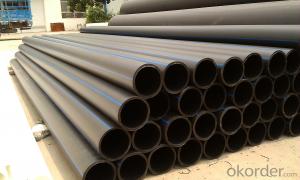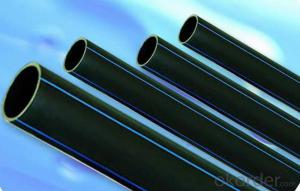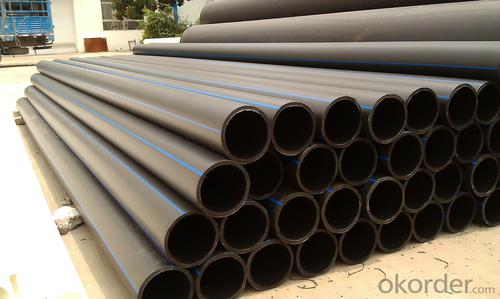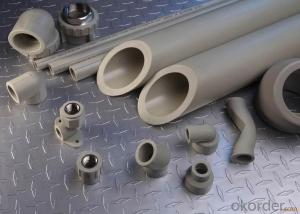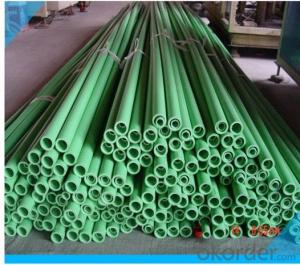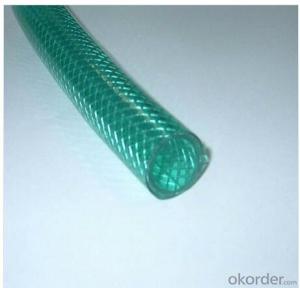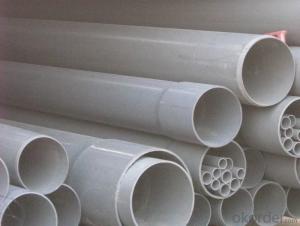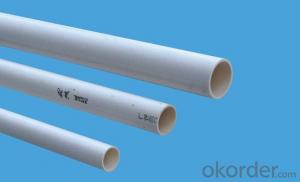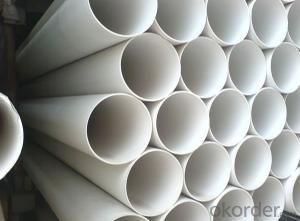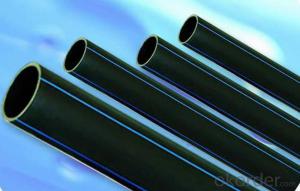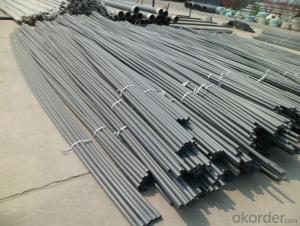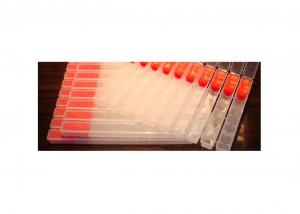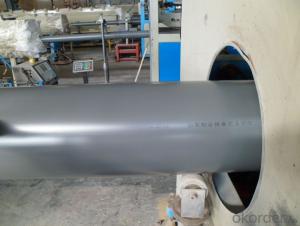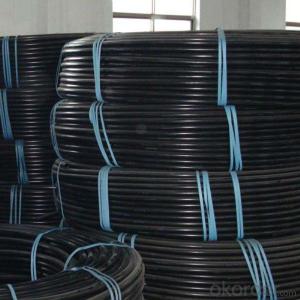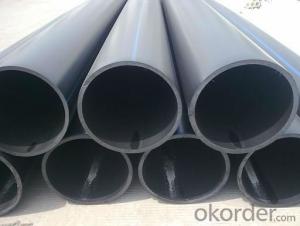Plastic Tubes HDPE Pipe ISO4427-2000 DN90
- Loading Port:
- China Main Port
- Payment Terms:
- TT OR LC
- Min Order Qty:
- -
- Supply Capability:
- -
OKorder Service Pledge
OKorder Financial Service
You Might Also Like
Physical properties[edit]
Polyethylene is a thermoplasticpolymer consisting of long hydrocarbon chains. Depending on the crystallinity and molecular weight, a melting point and glass transition may or may not be observable. The temperature at which these occur varies strongly with the type of polyethylene. For common commercial grades of medium- and high-density polyethylene the melting point is typically in the range 120 to 180 °C (248 to 356 °F). The melting point for average, commercial, low-density polyethylene is typically 105 to 115 °C (221 to 239 °F).it is transprant.
Chemical properties[edit]
Most LDPE, MDPE and HDPE grades have excellent chemical resistance, meaning that it is not attacked by strong acids or strong bases. It is also resistant to gentle oxidants and reducing agents. Polyethylene burns slowly with a blue flame having a yellow tip and gives off an odour of paraffin. The material continues burning on removal of the flame source and produces a drip.[3] Crystalline samples do not dissolve at room temperature. Polyethylene (other than cross-linked polyethylene) usually can be dissolved at elevated temperatures in aromatic hydrocarbons such as toluene or xylene, or in chlorinated solvents such as trichloroethane or trichlorobenzene.[4]
GB/T13663-2000:
| PE63管材规格 | |||||
| 公称 外径dn,mm | SDR33 | SDR26 | SDR17.6 | SDR13.6 | SDR11 |
| 公称压力 PN,Mpa | |||||
| 0.32 | 0.4 | 0.6 | 0.8 | 1.0 | |
| 公称 壁厚 | 公称 壁厚 | 公称 壁厚 | 公称 壁厚 | 公称 壁厚 | |
| 16 | 2.3 | ||||
| 20 | 2.3 | 2.3 | |||
| 25 | 2.3 | 2.3 | 2.3 | ||
| 32 | 2.3 | 2.4 | 2.9 | ||
| 40 | 2.3 | 2.3 | 3.0 | 3.7 | |
| 50 | 2.3 | 2.9 | 3.7 | 4.6 | |
| 63 | 2.3 | 2.5 | 3.6 | 4.7 | 5.8 |
| 75 | 2.3 | 2.9 | 4.3 | 5.6 | 6.8 |
| 90 | 2.8 | 3.5 | 5.1 | 6.7 | 8.2 |
| 110 | 3.4 | 4.2 | 6.3 | 8.1 | 10.0 |
| 125 | 3.9 | 4.8 | 7.1 | 9.2 | 11.4 |
| 140 | 4.3 | 5.4 | 8.0 | 10.3 | 12.7 |
| 160 | 4.9 | 6.2 | 9.1 | 11.8 | 14.6 |
| 180 | 5.5 | 6.9 | 10.2 | 13.3 | 16.4 |
| 200 | 6.2 | 7.7 | 11.4 | 14.7 | 18.2 |
| 225 | 6.9 | 8.6 | 12.8 | 16.6 | 20.5 |
| 250 | 7.7 | 9.6 | 14.2 | 18.4 | 22.7 |
| 280 | 8.6 | 10.7 | 15.9 | 20.6 | 25.4 |
| 315 | 9.7 | 12.1 | 17.9 | 23.2 | 28.6 |
| 355 | 10.9 | 13.6 | 20.1 | 26.1 | 32.2 |
| 400 | 12.3 | 15.3 | 22.7 | 29.4 | 36.3 |
| 450 | 13.8 | 17.2 | 25.5 | 33.1 | 40.9 |
| 500 | 15.3 | 19.1 | 28.3 | 36.8 | 45.4 |
| 560 | 17.2 | 21.4 | 31.7 | 41.2 | 50.8 |
| 630 | 19.3 | 24.1 | 35.7 | 46.3 | 57.2 |
- Q: How do plastic tubes compare to glass tubes in terms of fragility?
- Plastic tubes are generally less fragile than glass tubes.
- Q: Can plastic tubes be used for aquariums or fish tanks?
- Yes, plastic tubes can be used for aquariums or fish tanks. They can be employed for various purposes such as creating water flow, connecting filters or air pumps, or even as decorations. However, it is important to ensure that the plastic used is non-toxic and safe for aquatic life, as certain plastics may release harmful substances into the water.
- Q: I am hoping someone has designed a new, innovative style or shape of a bread box that is more functional as well. Is this a possibility or am I fantasizing about a bread box of the future? Anyone know where to buy one?
- How about working with a nationally renowned woodworking artist to incorporate your thoughts with their ability at an affordable price?
- Q: What is the maximum pressure plastic tubes can handle?
- The maximum pressure that plastic tubes can handle varies depending on the specific type and quality of the plastic, as well as factors such as diameter and wall thickness. Generally, plastic tubes can handle pressures ranging from a few hundred to several thousand pounds per square inch (psi). It is recommended to consult the manufacturer's specifications or conduct pressure testing to determine the maximum pressure capacity for a particular plastic tube.
- Q: What's the size of the PVC pipe?
- Rigid polyvinyl chloride pipe: it is made up of polyethylene resin, stabilizer, lubricant and so on. It is processed by kneading, rolling, plasticizing, cutting and extruding. The heating, heating, bending and cooling are available. Mainly used for wires, cables and other bushings. Pipe length is generally 4m / root, the color is generally gray. Pipe connections shall be heated, spigot and socket connections and plastic hot air welding. The bending must be heated.
- Q: I need it for a science experiment.It has to be thin and bendy/flexible, and not that long.Don't get confused with PVC piping, that's like 10 feet long, what I need is basically the same length as a straw, except it has to be bendy all the way.Regular straws don't work because I need to bend it 3 times, and still have the air flow through, but when i bend it, it's really tight and doesn't work.I need something like those plastic straws on juice bottles that can bend where the drinking part is, except something like that all the way through.If anybody could tell me where to get it (I only need one but will buy it in packages if the price is not too large) , or link me the website of the product, it would be greatly appreciated. Thanks!
- I worked with 1/8 Plexiglas, and I cut it with my scroll saw. I needed to use ultra-fine saw teeth to do the job. Two problems happened. First, when the saw blade was set at too high a speed, it melted the Plexiglas. This also happened if I did not move the Plexiglas fast enough. I had to have the top vibration clamp fairly close to the Plexiglas to stop it from jumping up. Before I realized this was necessary, I split 2 pieces. My project was see through drawer fronts for merchandise display. I had to predrill the holes for the screws to mount the fronts into the wood sides. I used masking tape on the area that was to be drilled to protect the Plexiglas surface. I still had breakage. Next time I do a project of this type, I will use thicker acrylic.
- Q: Is the PVC tube a plastic tube or a plastic tube?
- The vinyl chloride homopolymer and vinyl chloride copolymer are collectively referred to as vinyl chloride resins. The material is a non crystalline material. PVC materials often use stabilizers, lubricants, auxiliary processing agents, pigments, anti shock agents and other additives in practical use.
- Q: I would like to connect a Maytag icemaker valve to 1/4 plastic tubing. This is not for use in an actual ice maker. I've tried using a compression fitting from Home Depot, but it leaks between the tubing and fitting. Using the collar and insert pieces don't make a difference.Any idea on how to securely connect this two parts?
- I never did like plastic, try copper tubing.
- Q: Are plastic tubes recyclable?
- Yes, plastic tubes are recyclable. However, it is important to check with your local recycling facility to ensure that they accept plastic tubes for recycling, as some facilities may have specific guidelines or limitations.
- Q: How do you prevent plastic tubes from warping?
- To prevent plastic tubes from warping, it is important to avoid exposing them to high temperatures or extreme changes in temperature. Additionally, storing them in a cool and dry environment can help maintain their shape and prevent warping.
Send your message to us
Plastic Tubes HDPE Pipe ISO4427-2000 DN90
- Loading Port:
- China Main Port
- Payment Terms:
- TT OR LC
- Min Order Qty:
- -
- Supply Capability:
- -
OKorder Service Pledge
OKorder Financial Service
Similar products
Hot products
Hot Searches
Related keywords
